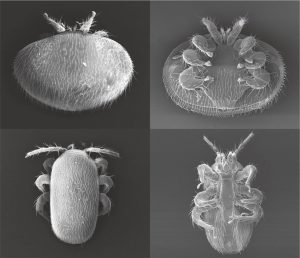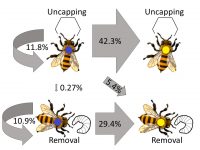We study the biotic interactions between the ectoparasitic mites of the genus Varroa and Tropilaelaps and its honey bee host and try to develop control strategies for these important pests. They vector viruses and weaken honey bees by feeding on important tissues. We seek to contribute to an Integrated Pest Management (IPM) approach. On the one hand, we are working on the development and evaluation of new Varroacides. On the other hand, we study natural defenses (e.g., hygienic behaviour) of the honey bees to assist the bees and give beekeepers tools for stock evaluation and selective breeding. Hygienic brood signals have led to the development of the novel UBeeO™ assay, available from Optera. The natural coexistence of Varroa with its original host Apis cerana ( the Eastern Honey Bee) exemplifies that a sustainable solution is possible and that we have a long way to go in understanding the relationships between these mites and their honey bee hosts from all angles.
 |
 |
 |
Bahreini R., Gonzales-Cabrera J., Hernandez-Rodriguez C.S., Moreno-Marti S., Muirhead S., Labuschagne R., Rueppell O. (2025) Arising amitraz and pyrethroids resistance mutations in the ectoparasitic Varroa destructor mite in Canada. Scientific Reports, 15:1587.
Reams T., Rueppell O., Rangel J. (2024) Honey bee (Apis mellifera) nurse bee visitation of worker and drone larvae increases Varroa destructor mite cell invasion. Journal of Insect Science, 24:16.
Barrs K.R., Ani M.O., Eversman K.K., Rowell J.T., Wagoner K.M., Rueppell O. (2021) Time-accuracy trade-off and task partitioning of hygienic behavior among honey bee (Apis mellifera) workers. Behavioral Ecology and Sociobiology, 75:12.
Wagoner K.M., Millar J., Schal C., Rueppell O. (2020) Cuticular pheromones stimulate hygienic behavior in the honey bee (Apis mellifera). Scientific Reports, 10: 7132.
Kuster R.D., Boncristiani H.F., Rueppell O. (2014) Immunogene and viral transcript dynamics during parasitic Varroa destructor (Anderson) mite infection of developing honey bee (Apis mellifera L) pupae. Journal of Experimental Biology, 217: 1710-1718.
